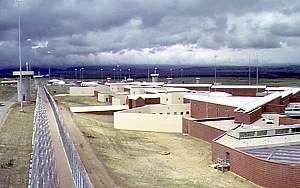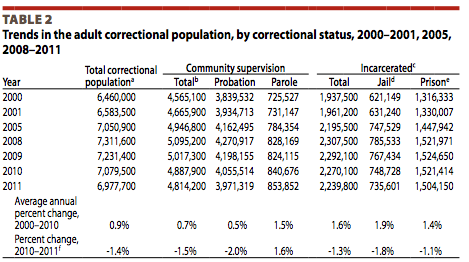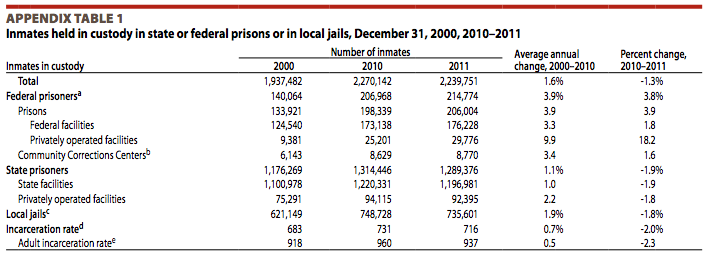America's Prison Population Is Finally Shrinking. Here's Why.
The number of adults under some form of correctional supervision in the U.S. has fallen from a historic high of 7.3 million in 2007, to 6.98 million in 2011.

The number of adults under some form of correctional supervision in the U.S. has fallen from a historic high of 7.3 million in 2007, to 6.98 million in 2011, according to a new report from the Bureau of Justice Statistics. Expressed as a ratio, 1 in 34 adults last year was a probate, a parolee, or a prisoner; down from 1 in 31 in 2007-2008. That's progress. Barely.
What explains the decline? The short answer is money. When the housing market crashed, cash-strapped states and cities were forced to take a hard look at their budgets. A lot of them realized they were spending insane amounts of money keeping nonviolent offenders in cages, so many increased funding for diversion programs like drug court and veterans court. Some states have also begun reducing penalties for parole and probation violations, which make up 75 percent of prison admissions in Texas, and cost Florida $100 million a year.
But these policy changes don't amount to opening the gates, as demonstrated by the chart below:

And none of those policies address head-on the single biggest growth driver for prison populations in the country: Draconian drug policies. In Wisconsin, for instance, the state's prison population has tripled since 1990, and 80 percent of that growth came from drug and alcohol convictions. Florida's prison population has quadrupled since 1984. According to Florida TaxWatch, the state spent $300 million in 2011 incarcerating drug offenders.
To the extent that you can quickly reduce a state's prison population, it's by lessening penalties for drug-related and victimless crimes. That's why the decline is happening at the state level, and not the federal level, where diversion is not an option, sentencing is less flexible, and early release is rare. In fact, the federal prison population is actually growing. In 2006, the federal corrections system oversaw 176,824 offenders. In 2011, it oversaw 214,000 offenders. You can see that growth in this chart:

According to a recent GAO report on the Bureau of Prisons, which we wrote up here, the agency expects the federal prison population to grow every year for at least the next decade. But it doesn't have to. Drug offenders make up more than half of the federal prison population, and the next highest offender population is people who have violated immigration laws. These people don't need to be behind bars, and it's strange to think that fewer of them would be if the federal government were unable to spend money it doesn't have.


Show Comments (30)